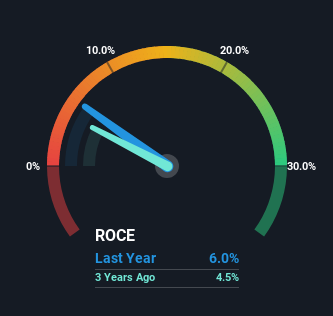- China
- /
- Personal Products
- /
- SHSE:603059
Capital Allocation Trends At Perfect Group (SHSE:603059) Aren't Ideal
What are the early trends we should look for to identify a stock that could multiply in value over the long term? Ideally, a business will show two trends; firstly a growing return on capital employed (ROCE) and secondly, an increasing amount of capital employed. Put simply, these types of businesses are compounding machines, meaning they are continually reinvesting their earnings at ever-higher rates of return. However, after investigating Perfect Group (SHSE:603059), we don't think it's current trends fit the mold of a multi-bagger.
What Is Return On Capital Employed (ROCE)?
Just to clarify if you're unsure, ROCE is a metric for evaluating how much pre-tax income (in percentage terms) a company earns on the capital invested in its business. Analysts use this formula to calculate it for Perfect Group:
Return on Capital Employed = Earnings Before Interest and Tax (EBIT) ÷ (Total Assets - Current Liabilities)
0.06 = CN¥93m ÷ (CN¥2.2b - CN¥676m) (Based on the trailing twelve months to September 2024).
Therefore, Perfect Group has an ROCE of 6.0%. On its own, that's a low figure but it's around the 6.6% average generated by the Personal Products industry.
Check out our latest analysis for Perfect Group

Above you can see how the current ROCE for Perfect Group compares to its prior returns on capital, but there's only so much you can tell from the past. If you'd like to see what analysts are forecasting going forward, you should check out our free analyst report for Perfect Group .
What Does the ROCE Trend For Perfect Group Tell Us?
On the surface, the trend of ROCE at Perfect Group doesn't inspire confidence. Over the last five years, returns on capital have decreased to 6.0% from 12% five years ago. However, given capital employed and revenue have both increased it appears that the business is currently pursuing growth, at the consequence of short term returns. And if the increased capital generates additional returns, the business, and thus shareholders, will benefit in the long run.
On a side note, Perfect Group's current liabilities have increased over the last five years to 30% of total assets, effectively distorting the ROCE to some degree. Without this increase, it's likely that ROCE would be even lower than 6.0%. While the ratio isn't currently too high, it's worth keeping an eye on this because if it gets particularly high, the business could then face some new elements of risk.
Our Take On Perfect Group's ROCE
In summary, despite lower returns in the short term, we're encouraged to see that Perfect Group is reinvesting for growth and has higher sales as a result. And there could be an opportunity here if other metrics look good too, because the stock has declined 14% in the last five years. So we think it'd be worthwhile to look further into this stock given the trends look encouraging.
Like most companies, Perfect Group does come with some risks, and we've found 3 warning signs that you should be aware of.
While Perfect Group may not currently earn the highest returns, we've compiled a list of companies that currently earn more than 25% return on equity. Check out this free list here.
New: Manage All Your Stock Portfolios in One Place
We've created the ultimate portfolio companion for stock investors, and it's free.
• Connect an unlimited number of Portfolios and see your total in one currency
• Be alerted to new Warning Signs or Risks via email or mobile
• Track the Fair Value of your stocks
Have feedback on this article? Concerned about the content? Get in touch with us directly. Alternatively, email editorial-team (at) simplywallst.com.
This article by Simply Wall St is general in nature. We provide commentary based on historical data and analyst forecasts only using an unbiased methodology and our articles are not intended to be financial advice. It does not constitute a recommendation to buy or sell any stock, and does not take account of your objectives, or your financial situation. We aim to bring you long-term focused analysis driven by fundamental data. Note that our analysis may not factor in the latest price-sensitive company announcements or qualitative material. Simply Wall St has no position in any stocks mentioned.
About SHSE:603059
Perfect Group
Provides manual and electric toothbrushes in the People’s Republic of China.
Reasonable growth potential and fair value.
Market Insights
Community Narratives



